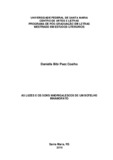| dc.creator | Coelho, Daniella Bibi Paez | |
| dc.date.accessioned | 2018-09-18T21:20:27Z | |
| dc.date.available | 2018-09-18T21:20:27Z | |
| dc.date.issued | 2018-03-01 | |
| dc.identifier.uri | http://repositorio.ufsm.br/handle/1/14351 | |
| dc.description.abstract | This work aims to present an analytical panorama of the twenty-three madrigals in Portuguese language, constant in the multilingual work Musica do Parnasso (1705), by Manuel Botelho de Oliveira (Salvador, 1636-1711), under the point of view of the acute construction. For this, in the first chapter we present a brief biographical excursus and the appreciation of the work and the critical fortune of the author, letting know and commenting the prologue of a manuscript work, until then unpublished, Jardim historial de conceituosas flores (1704), which updates his own bibliography. In the second chapter, we discuss some fundamental theoretical points for the study of corpus in question: the difficult definition of the lyrical genres and the primacy of the loving themes; the relation of poetry with rhetoric; the practice of engenho and agudeza; the specific case of madrigal in the treatises of poetry of the time and its relation with music. In the third chapter, we weave a general comment about the forty-eight madrigals (in Portuguese, Castilian and Italian) composed by the author, presenting elocutory similarities, and we proceed to the analysis of twenty-three madrigals in Portuguese language, divided in semantic axes, emphasizing the rhetorical procedures, in order to extract the metaphorical lights and the sounds of the madrigals by Botelho and from them present a panorama. Likewise, once that in Musica do Parnasso many poems are in honor to Anarda and from this fictional beloved celebrate the beauty and the rigors, we propose, also, the thesis that from her composes an etopeia, that is, a physical and moral portrait, and, since the madrigals analyzed integrate this honor, from this thesis make equally proof. | eng |
| dc.description.sponsorship | Coordenação de Aperfeiçoamento de Pessoal de Nível Superior - CAPES | por |
| dc.language | por | por |
| dc.publisher | Universidade Federal de Santa Maria | por |
| dc.rights | Attribution-NonCommercial-NoDerivatives 4.0 International | * |
| dc.rights.uri | http://creativecommons.org/licenses/by-nc-nd/4.0/ | * |
| dc.subject | Poesia de agudeza | por |
| dc.subject | Madrigal | por |
| dc.subject | Botelho de Oliveira | por |
| dc.subject | Acuteness poem | eng |
| dc.subject | Madrigal | eng |
| dc.subject | Botelho de Oliveira | eng |
| dc.title | As luzes e os sons madrigalescos de um Botelho innamorato | por |
| dc.title.alternative | The madrigal lights and sounds of a Botelho innamorato | eng |
| dc.type | Dissertação | por |
| dc.description.resumo | Este trabalho tem como objetivo apresentar um panorama analítico dos vinte e três madrigais em língua portuguesa, constantes na obra multilíngue Musica do Parnasso (1705), de Manuel Botelho de Oliveira (Salvador, 1636-1711), sob o ponto de vista da construção aguda. Para tal, no primeiro capítulo, apresentamos um breve excurso biográfico e a apreciação das obras e da fortuna crítica do autor, apresentando e comentando o prólogo de uma obra manuscrita, até então inédita, Jardim historial de conceituosas flores (1704), o que atualiza sua própria bibliografia. No segundo capítulo, discutimos alguns pontos teóricos fundamentais para o estudo do corpus em questão: a difícil definição dos gêneros líricos e o primado da temática amorosa; a relação da poesia com a retórica; a prática do engenho e da agudeza; o caso específico do madrigal nos tratados de poesia da época e sua relação com a música. No terceiro capítulo, procedemos: a um comentário geral sobre os quarenta e oito madrigais (em português, castelhano e italiano) compostos pelo autor, apresentando-lhes semelhanças elocutórias; à análise dos vinte e três madrigais em língua portuguesa, divididos em eixos semânticos, enfatizando-lhes os procedimentos retóricos, a fim de extrair as luzes metafóricas e os sons dos madrigais botelhianos e deles apresentar um panorama. Outrossim, uma vez que em Musica do Parnasso muitos poemas são em louvor a Anarda e dessa amada ficcional celebram a beleza e o rigores, propomos, ainda, a tese de que dela compõem uma etopeia, ou seja, um retrato físico e moral, e, visto que os madrigais analisados integram esse louvor, dessa tese fazem-se igualmente comprovação. | por |
| dc.contributor.advisor1 | De Martini, Marcus | |
| dc.contributor.advisor1Lattes | http://lattes.cnpq.br/6710912583881896 | por |
| dc.contributor.referee1 | Pereira, Lawrence Flores | |
| dc.contributor.referee1Lattes | http://lattes.cnpq.br/2329033954605102 | por |
| dc.contributor.referee2 | Carvalho, Maria do Socorro Fernandes de | |
| dc.contributor.referee2Lattes | http://lattes.cnpq.br/2387705062124892 | por |
| dc.creator.Lattes | http://lattes.cnpq.br/5679321741222384 | por |
| dc.publisher.country | Brasil | por |
| dc.publisher.department | Letras | por |
| dc.publisher.initials | UFSM | por |
| dc.publisher.program | Programa de Pós-Graduação em Letras | por |
| dc.subject.cnpq | CNPQ::LINGUISTICA, LETRAS E ARTES::LETRAS | por |
| dc.publisher.unidade | Centro de Artes e Letras | por |



